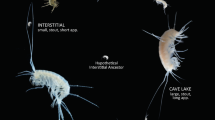Abstract
Adaptive radiations are generally considered to be periods of rapid evolutionary change1. Simpson2 viewed rates of evolution as either taxonomic or morphological and various methods for their quan-tification are widely used1,3–5. In contrast to classic studies of extant organisms6–7, adaptive radiations of fossil groups are usually analysed on the superspecific (for example, generic or familial) level. But relatively few studies have dealt with the patterns and processes of adaptive radiations for fossil species. The principal adaptive radiation of grazing horses occurred in North America 15 to 18 million years ago (Myr BP), when at least 19 species originated by cladogenesis. We report here that the pattern of horse taxonomic evolution is logistic, with very high origination rates observed early during the radiation. By 15 Myr BP diversity reached a plateau of about 16 contemporaneous grazing species, and this taxonomic carrying capacity continued until about 6 Myr BP. In contrast, rates of morphological (dental) evolution during the period were 'normal' (or holotelic) relative to other known fossil groups. Thus, adaptive radiations are times of rapid cladogenesis, but not necessarily rapid morphological change.
This is a preview of subscription content, access via your institution
Access options
Subscribe to this journal
Receive 51 print issues and online access
$199.00 per year
only $3.90 per issue
Buy this article
- Purchase on Springer Link
- Instant access to full article PDF
Prices may be subject to local taxes which are calculated during checkout
Similar content being viewed by others
References
Stanley, S. M. Macroevolution (Freeman, San Francisco, 1979).
Simpson, G. G. The Major Features of Evolution (Columbia University Press, New York, 1953).
Stanley, S. M. Paleobiology 10, 13–26 (1985).
Gingerich, P. D. Proc. 3rd N. Am. Paleont. Conv. 1, 205–210 (1982).
MacFadden, B. J. Paleobiology 11, 245–257 (1985).
Lack, D. Darwin's Finches (Cambridge Univ. Press, Cambridge, 1947).
Greenwood, P. H. Bull. Br. Mus. (Nat. Hist.), Zool. Suppl. 6, 1–134 (1974).
Matthew, W. D. Q. Rev. Biol. 1, 139–185 (1926).
Stirton, R. A. Univ. California Pub. Bull. Dept. Geol. Sci. 25, 165–198 (1940).
Hulbert, R. C. & MacFadden, B. J. Am. Mus. Novit. (in the press).
MacFadden, B. J. Bull. Am. Mus. Nat. Hist. 179, 1–196 (1984).
Hulbert, R. C. thesis, Univ. Florida (1987).
Hulbert, R. C. Bull. Florida State Mus., Biol. Sci. 32, 221–340 (1988).
Swofford, D. L. PAUP, Phylogenetic Analysis Using Parsimony (Illinois nat. Hist. Survey, Champaign, 1985).
Tedford, R. H. in Cenozoic Mammals of North America (ed. Woodburne, M. O.) (Univ. California Press, Berkeley, 1988).
Cracraft, J. Syst. Zool. 31, 348–365 (1982).
Novacek, M. J. & Norell, M. A. Syst. Zool. 31, 366–375 (1982).
Haldane, J. B. S. Evolution 3, 51–56 (1949).
Webb, S. D. & Hulbert, R. C. in Vertebrates Phytogeny and Philosophy (eds Flanagan, K. M. & Lillegraven, J. A.) (Univ. Wyoming, Laramie, 1986).
MacFadden, B. J. Biol. J. Linn. Soc. 35, 37–48 (1988).
Hulbert, R. C. Bull. Florida Stale Mus., Biol. Sci. 33, 229–238 (1988).
Author information
Authors and Affiliations
Rights and permissions
About this article
Cite this article
MacFadden, B., Hulbert, R. Explosive speciation at the base of the adaptive radiation of Miocene grazing horses. Nature 336, 466–468 (1988). https://doi.org/10.1038/336466a0
Received:
Accepted:
Issue Date:
DOI: https://doi.org/10.1038/336466a0
This article is cited by
-
Evolution of the power stroke in early Equoidea (Perissodactyla, Mammalia)
Palaeobiodiversity and Palaeoenvironments (2019)
-
The record of Cenozoic horses in Mexico: current knowledge and palaeobiological implications
Palaeobiodiversity and Palaeoenvironments (2016)
-
Two new carnivores from an unusual late Tertiary forest biota in eastern North America
Nature (2004)
Comments
By submitting a comment you agree to abide by our Terms and Community Guidelines. If you find something abusive or that does not comply with our terms or guidelines please flag it as inappropriate.



